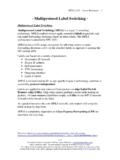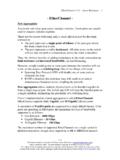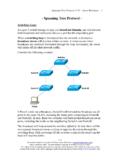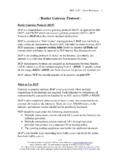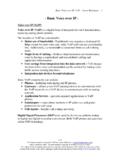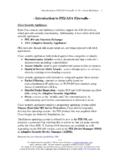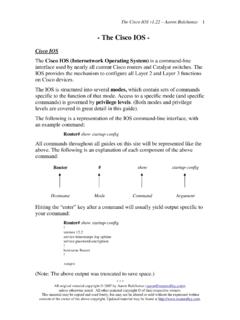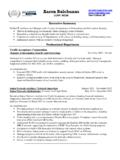Transcription of Virtual LANs (VLANs) and VTP - Router Alley
1 Virtual lans ( vlans ) and vtp aaron balchunas * * * All original material copyright 2014 by aaron balchunas unless otherwise noted. All other material copyright of their respective owners. This material may be copied and used freely, but may not be altered or sold without the expressed written consent of the owner of the above copyright. Updated material may be found at 1- Virtual lans ( vlans ) and vtp - Collision vs. Broadcast Domains A collision domain is simply defined as any physical segment where a collision can occur. Hubs can only operate at half-duplex, and thus all ports on a hub belong to the same collision domain. Layer-2 switches can operate at full duplex. Each individual port on a switch belongs to its own collision domain. Thus, Layer-2 switches create more collision domains, which results in fewer collisions.
2 Like hubs though, Layer-2 switches belong to only one broadcast domain. A Layer-2 switch will forward both broadcasts and multicasts out every port but the originating port. Only Layer-3 devices separate broadcast domains. Because of this, Layer-2 switches are poorly suited for large, scalable networks. The Layer-2 header provides no mechanism to differentiate one network from another, only one host from another. Virtual lans ( vlans ) By default, a switch will forward both broadcasts and multicasts out every port but the originating port. However, a switch can be logically segmented into separate broadcast domains, using Virtual lans (or vlans ). Each VLAN represents a unique broadcast domain: Traffic between devices within the same VLAN is switched. Traffic between devices in different vlans requires a Layer-3 device to communicate.
3 Broadcasts from one VLAN will not be forwarded to another VLAN. The logical separation provided by vlans is not a Layer-3 function. VLAN tags are inserted into the Layer-2 header. Thus, a switch that supports vlans is not necessarily a Layer-3 switch. However, a purely Layer-2 switch cannot route between vlans . Remember, though vlans provide separation for Layer-3 broadcast domains, they are still a Layer-2 function. A VLAN often has a direct relationship with an IP subnet, though this is not a requirement. Virtual lans ( vlans ) and vtp aaron balchunas * * * All original material copyright 2014 by aaron balchunas unless otherwise noted. All other material copyright of their respective owners. This material may be copied and used freely, but may not be altered or sold without the expressed written consent of the owner of the above copyright.
4 Updated material may be found at 2 VLAN Example Consider the following example: Four hosts are connected to a Layer-2 switch that supports vlans : HostA and HostB belong to VLAN 100 HostC and HostD belong to VLAN 200 Because HostA and HostB belong to the same VLAN, they belong to the same broadcast domain as well. The switch will be able to forward frames between the two hosts without the need of a Layer-3 device, such as a Router . Likewise, HostC and HostD belong to the same VLAN, and thus the same broadcast domain. They also will be able to communicate without an intervening Layer-3 device. However, HostA and HostB will not be able to communicate with HostC and HostD. They are members of separate vlans , and belong in different broadcast domains.
5 Thus, a Layer-3 device is required for those hosts to communicate. A broadcast sent from a host in VLAN 100 will be received by all other hosts in that same VLAN. However, that broadcast will not be forwarded to any other VLAN, such as VLAN 200. On Cisco switches, all interfaces belong to VLAN 1 by default. VLAN 1 is also considered the Management VLAN, and should be dedicated for system traffic such as CDP, STP, VTP, and DTP. Virtual lans ( vlans ) and vtp aaron balchunas * * * All original material copyright 2014 by aaron balchunas unless otherwise noted. All other material copyright of their respective owners. This material may be copied and used freely, but may not be altered or sold without the expressed written consent of the owner of the above copyright.
6 Updated material may be found at 3 Advantages of vlans vlans provide the several benefits: Broadcast Control eliminates unnecessary broadcast traffic, improving network performance and scalability. Security logically separates users and departments, allowing administrators to implement access-lists to control traffic between vlans . Flexibility removes the physical boundaries of a network, allowing a user or device to exist anywhere. vlans are very common in LAN and campus networks. For example, user networks are often separated from server networks using vlans . vlans can span across WANs as well, though there are only limited scenarios where this is necessary or recommended. VLAN Membership VLAN membership can be configured one of two ways: Statically Dynamically Statically assigning a VLAN involves manually assigning an individual or group of ports to a VLAN.
7 Any host connected to that port (or ports) immediately becomes a member of that VLAN. This is transparent to the host - it is unaware that it belongs to a VLAN. vlans can be assigned dynamically based on the MAC address of the host. This allows a host to remain in the same VLAN, regardless of which switch port it is connected to. Dynamic VLAN assignment requires a separate database to maintain the MAC-address-to-VLAN relationship. Cisco developed the VLAN Membership Policy Server (VMPS) to provide this functionality. In more sophisticated systems, a user s network account can be used to determine VLAN membership, instead of a host s MAC address. Static VLAN assignment is far more common than dynamic, and will be the focus of this guide. Virtual lans ( vlans ) and vtp aaron balchunas * * * All original material copyright 2014 by aaron balchunas unless otherwise noted.
8 All other material copyright of their respective owners. This material may be copied and used freely, but may not be altered or sold without the expressed written consent of the owner of the above copyright. Updated material may be found at 4 Creating vlans By default, all interfaces belong to VLAN 1. To assign an interface to a different VLAN, that VLAN must first be created: Switch(config)# vlan 100 Switch(config-vlan)# name SERVERS The first command creates VLAN 100, and enters VLAN configuration mode. The second command assigns the name SERVERS to this VLAN. Note that naming a VLAN is not required. The standard range of VLAN numbers is 1 1005, with vlans 1002-1005 reserved for legacy Token Ring and FDDI purposes. A switch operating in VTP transparent mode can additionally use the VLAN range of 1006 4094.
9 These are known as extended-range vlans . VTP is covered in great detail later in this guide. To remove an individual VLAN: Switch(config)# no vlan 100 Note that VLAN 1 cannot be removed. To remove a group of vlans : Switch(config)# no vlan 150-200 To view all created vlans , including the interfaces assigned to each VLAN: Switch# show vlan VLAN Name Status Ports ---- -------------------------- --------- ----------- 1 default active gi1/1-24 100 SERVERS active 1002 fddi-default suspended 1003 token-ring-default suspended 1004 fddinet-default suspended 1005 trnet-default suspended Note that no interfaces have been assigned to the newly created VLAN 100 yet.
10 Virtual lans ( vlans ) and vtp aaron balchunas * * * All original material copyright 2014 by aaron balchunas unless otherwise noted. All other material copyright of their respective owners. This material may be copied and used freely, but may not be altered or sold without the expressed written consent of the owner of the above copyright. Updated material may be found at 5 Statically Assigning vlans To statically assign an interface into a specific VLAN: Switch(config)# interface gi1/10 Switch(config-if)# switchport mode access Switch(config-if)# switchport access vlan 100 The first command enters interface configuration mode. The second command indicates that this is an access port, as opposed to a trunk port. This will be explained in detail shortly.

